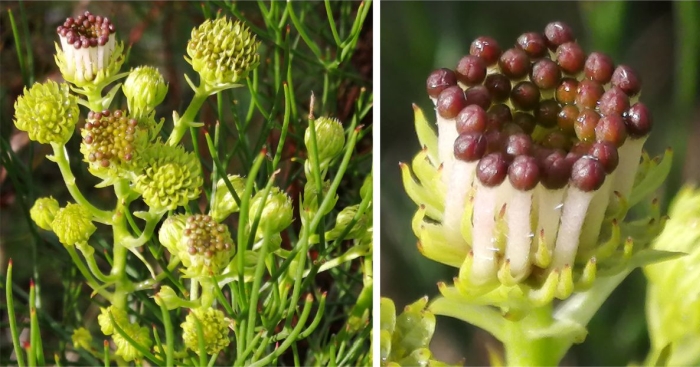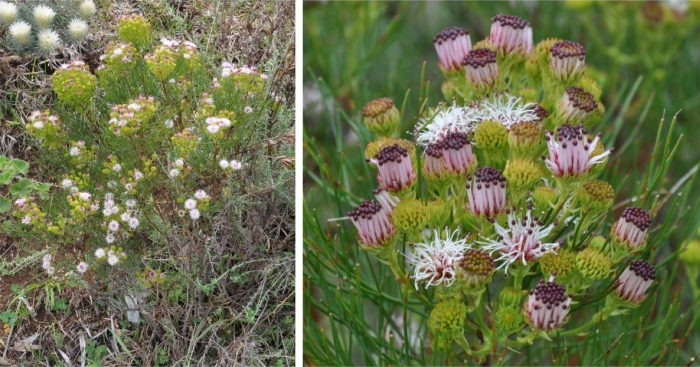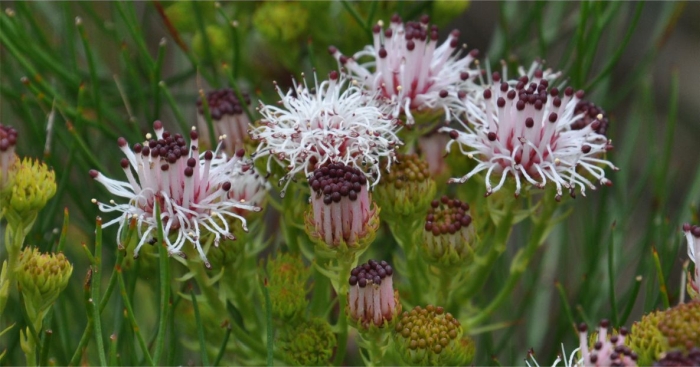Serruria zeyheri
Serruria zeyheri Meisn.
Family: Proteaceae
Common names: matchstick spiderhead (Eng.); vuurhoutjiespinnekopbossie (Afr.)
Introduction
A rarely seen, rounded shrub with impressive, loosely aggregated flowerheads made up of flowers that look like matchsticks before they open.

Description
Description
Serruria zeyheri is an evergreen shrub that grows up to 0.5 m high and 0.5 m wide, with a stem that gets to 10 mm in diameter. The erect leaves are 150 mm long and 80 mm wide, on a 20-30 mm leaf stalk, dissected (finely divided), having 15-25 tips, with acute points, and hairless when mature.
Serruria zeyheri produces 40-55 mm long and 60-70 mm wide inflorescences above the leaves. The flowerheads are flat on top, with 15-30 headlets, and each headlet carries 25 flowers. While the plant is in bud, it manifests a white to pinkish white tubular perianth with glossy, hairless, black tips, opening to release a straight, 10 mm long style and a 1 mm long pollen presenter that forms a knob at the tip. The flowers have adpressed hairs, and the bracts are glabrous and oblong lanceolate. Serruria zeyheri begins to flower in late winter (August) and continues to early summer (November) and begins to release the seed 2 months after flowering. At Kirstenbosch, the plants have been observed flowering earlier, in the last weeks of June.

Conservation Status
Status
Serruria zeyheri is assessed as an Endangered (EN) on the Red List of South African Plants. The threats are the expansion of agriculture, which leads to habitat loss, and the spread of alien invasive plants. The population has declined by 90% and some subpopulations are extinct and are today known only by the herbarium records over the past 60 years. The remaining 250 individual plants are found in two locations within an area of 109 km2.
Distribution and habitat
Distribution description
Serruria zeyheri is rarely seen in its natural habitat, in cool or moist elevated positions on sandstone and peaty slopes, at 760-1220 m altitude, in the Du Toit’s Kloof, Franschhoek and Riviersonderend Mountains. There is a possibility that it may also be found in the Groenland Mountains.

Derivation of name and historical aspects
History
The genus Serruria is named in honour of J. Serrurier, a botany professor at University of Utrecht in the early eighteenth century. This species is one of the several species, including Orothamnus zeyheri and Erythrina zeyheri, that are named after C.L. Zeyher, a botanical explorer from Germany, who visited southern Africa in 1822 with a commercial collector of natural history specimens W.W. Sieber.
The genus Serruria have bisexual, regular flowers with four perianth segments that are recurved or spreading and united only at the base or near the base.

Ecology
Ecology
Serruria zeyheri is one of the fynbos species that are dependent on ecological fire for regeneration. This is a reseeder species, which means that the plants are killed by fire and regenerate by seeds stored underground. The mature fruits are shed from older flowers, on the edge of the flowerhead; this process begins while the flowers in the center of the flowerhead are still fresh or have just finished flowering.
The fruits contain an elaiosome that ants feed on. Whilst the fruits are attached to the flowerhead, at the bottom of each seed the elaiosome remains hidden. When the fruits drop to the ground, the oily lumps (protuberances) are revealed; they attract ants. The ants carry the seeds to their nests where the elaiosomes are eaten but the fruits are discarded and remain unharmed in the nest, while protected from been eaten by rodents. The seeds will germinate after the fire and winter rain.
Serruria zeyheri flowers are pollinated by insects, which are attracted by the scents that the flower produces.
Uses
Use
Serruria zeyheri is one of the species that have excellent horticultural potential in fynbos gardens. They make a very impressive display in the fynbos garden with their matchstick-like flowers. The plants are growing well and are healthy in the well-drained granite soils at Kirstenbosch, and are good companions with Phylica pubescens and Leucadendron stelligerum.

Growing Serruria zeyheri
Grow
Serruria zeyheri can be propagated by both seeds and cuttings. However, the seeds are not easy to collect or find as they drop immediately when ripe. The seeds are sowed in late summer to autumn (February to April) in the Western Cape, when the temperate begins to drop and it is cool during the nights. The seeds are treated with systemic fungicides prior to sowing to prevent pre-and post-emergence damping-off fungi and are exposed to smoke after sowing, to break the dormancy of the seed. Use a well-aerated fynbos medium, preferably between 5-7 pH levels.
Cuttings are done from summer to autumn, semi-hard cuttings are collected in the early morning while it is still cool. Cut them about 30-70 mm long and dip them in the semi-hardwood rooting hormone and insert in the propagation medium. Place the trays in the mist house on the warm benches of about 25°C until they start rooting. Move the rooted cuttings to the hardening off area for 2-3 weeks. Transplant the seedlings and cuttings in the bag or pots and let them grow until they are ready to be planted in the garden.
Feed the plants with organic fertilizers. To avoid root disturbance, dryness and weeds, apply a layer of 5 mm mulch in the bed. Chipping mulch is much recommended as it breaks down very slowly and releases small amounts of nutrients to the plants. The plants do not need pruning maintenance in the garden.
References
- Duncan, G., Brown, N. & Nurrish, L. 2013. Grow proteas. Kirstenbosch Gardening Series. South African National Biodiversity Institute, Cape Town.
- Harvey, W., Sonder, O. & Thiselton- Dyer, W. 1859. Serruria zeyheri. Flora capensis p. 683.
- Manning, J. & Goldblatt, P. 2012. Plants of the Greater Cape Floristic Region 1: the Core Cape Flora. Strelitzia 29. South African National Biodiversity Institute, Pretoria.
- Plug, C. 2020. S2A3 Biographical Database of Southern African Science. https://www.s2a3.org.za/bio/Biograph_final.php?serial=3227. Accessed 12 07 2021.
- Protea Atlas Project. Meanings of scientific names. http://www.proteaatlas.org.za/meanings.htm
- Rebelo, A.G. 2001. Proteas. A field guide to the proteas of southern Africa. Fernwood Press, Vlaeberg, Cape Town.
- Rourke, J., 1990. Four new species of Serruria (Proteaceae) from the south-western Cape. South African Journal of Botany, 56(4):505.
- Vogts, M. 1982. South Africa's Proteaceae: know them and grow them. Struik, Cape Town.
Credits
Mane Somtshu & Mashudu Nndanduleni
Kirstenbosch National Botanical Garden
June 2022
Plant Attributes:
Plant Type: Shrub
SA Distribution: Western Cape
Soil type: Sandy, Loam
Flowering season: Spring, Early Summer, Winter
PH: Acid
Flower colour: Black, White, Pink
Aspect: Full Sun
Gardening skill: Average
Special Features:
Horticultural zones








Rate this article
Article well written and informative
Rate this plant
Is this an interesting plant?
Login to add your Comment
Back to topNot registered yet? Click here to register.